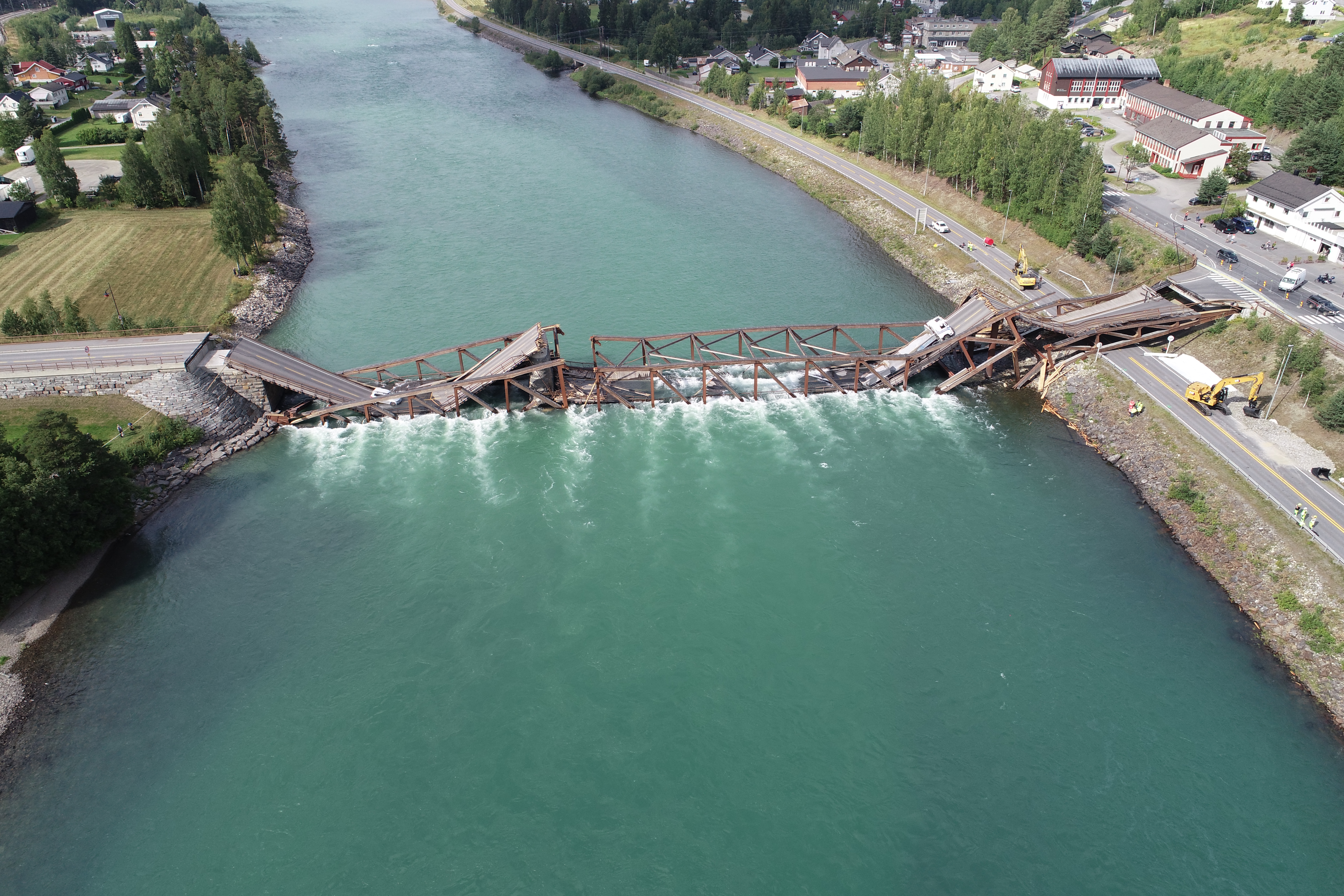
+ Norwegian Safety Investigation Authority
On the morning of 15 August 2022, Tretten Bridge collapsed, and fell into the river Gudbrandsdalslågen and onto the E6 highway, after having been in operation for approx. 10 years. Tretten bridge was an architect-designed truss bridge in glulam and steel. Sub-report 2 focuses on the management and follow-up of Tretten Bridge throughout its life cycle.
The investigation has shown that inadequate caution was exercised in the planning, design, control and approval of Tretten bridge, and that the follow-up of the bridge failed in 2016. Inadequate knowledge and learning after previous incidents is also an important explanation for the collapse of Tretten Bridge. With respect to future bridge management, the investigation raises some fundamental questions.
_
Main conclusion of technical investigations
Tretten Bridge collapsed most likely as a result of block shear failure in one of the timber diagonal members near the river foundation in the western part of the river. It is predominantly likely that the fracture location in question has been exposed to weakening over time (fatigue). This is described in more detail in sub-report 1.
Main conclusion of investigation of the bridge’s life cycle and history
Tretten bridge was an architect-designed truss bridge in glulam and steel, and was constructed by the NPRA in 2012 as part of the project E6 highway Øyer-Tretten. The investigation has shown that inadequate caution was exercised in the planning, design, inspection and approval of Tretten Bridge, with respect to the risk factors linked to its unconventional design. A short construction period, span lengths and reuse of existing foundation were framework conditions for the planning of the bridge. These framework conditions, combined with the choice of material and a strong focus on aesthetics, contributed to the structure not being robust.
Tretten Bridge was designed during a transitional period between old and new regulations. According to the transitional provisions, the project had the opportunity to relate to the old regulations. In retrospect, all the involved parties can be criticised for selecting and accepting regulations that proved to have a serious shortcoming (block shear failure). However, the transition from national standards to European standards for structural design (Eurocodes) was extensive and complex.
Block shear is a form of fracture that has been included in the Eurocodes since 2004, as a result of a building collapse in Finland in 2003. However, block shear failure was not covered in the previous Norwegian standard that formed the basis for the design of Tretten Bridge in 2009–2011. The investigation has shown that there was insufficient transfer of knowledge about the criticality of block shear failure from its implementation in the Eurocodes until the collapse of Tretten Bridge.
After the collapse of Perkolo Bridge in 2016, Tretten Bridge was re-calculated according to the current regulations with check against block shear failure by the NPRA. The NPRA identified serious faults in Tretten Bridge, but it was not evaluated and followed up in a systematic manner. This represents a system failure in the NPRA, reflecting a lack of knowledge about block shear failure, as well as shortcomings in the bridge management system and risk management. An important basis for managing risk is that the precautionary principle should be applied when the consequences are potentially extensive and there is inadequate knowledge about the issue. The NSIA believes that Tretten Bridge should either immediately have been closed or traffic restrictions imposed in 2016 when finding over-utilisation in relation to block shear in several of the bridge’s connections.
The regional government reform of 2020 has posed some challenges related to the clarification of responsibilities between the NPRA and Innlandet County Authority. However, the resources, expertise and systems employed by the county authority’s bridge management have had no bearing on the collapse of Tretten Bridge.
Safety learning
The external review of bridge management and the history of Tretten Bridge, which PwC has conducted on behalf of the NPRA, has identified several areas for improving safety. The NPRA has launched several relevant and important measures that will address many of the safety issues identified in the investigation.
Inadequate knowledge and learning after previous incidents is one important explanation for the collapse of Tretten Bridge. The NSIA therefore considers it important that this investigation provides safety lessons for relevant stakeholders, both in Norway and internationally. With respect to future bridge management, the investigation also raises some fundamental questions related to crisis management in the road sector, the supervisory authority for county roads, the Directorate of Public Roads’ exercise of authority, as well as the management and application of regulations.
The NSIA submits six safety recommendations following the investigation.

